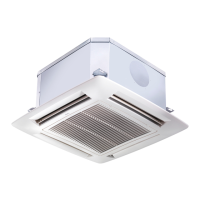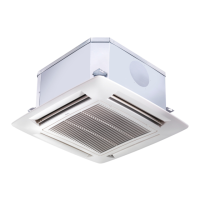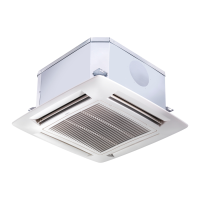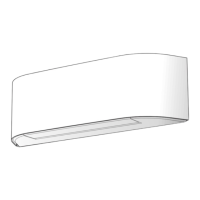Fresh air renewal and conditioned air
supply to an adjacent room
See g. 44 - 45.
Side knockouts allow connection of fresh air inlet ducts and ducts to •
deliver conditioned air to an adjacent room.
Remove the external prepunched anti-condensate insulation and •
take away the knockout panels using a punch.
Air distribution to adjacent room
With a pencil, trace a line on the polystyrene around the inside edges of
the panel that was previously removed.
Cut away the polystyrene with a knife, taking care not to damage the
heat exchange coil.
Fresh air intake
Remove the polystyrene partition.
Introduce the bae supplied after the frame has been hooked as per
above gure.
Following that tighten the assembly frame/grille using the 4 screws.
Use locally purchased material, suitable for operating temperatures •
of 60 °C (continuous). Conduits can be of exible polyester (with
spiral core) or corrugated aluminium, externally covered with anti-
condensate material (bre glass of 12 +/- 25 mm thickness).
To complete the installation, all non-insulated ducts must be covered •
with anti-condensate insulation (ex. expanded neoprene, 6 mm
thickness).
If these instructions are not observed, condensate may drip; the
manufacturer will not be held responsible for any damage caused.
The two prepunched side knockouts must not be used at the same •
time to deliver conditioned air to an adjacent room.
The return and supply duct lengths can be calculated in accordance •
with the "air distribution to an adjacent room" and "fresh air renewal"
diagrams (also taking into account the pressure drop through air
diusers, grilles and fresh air lters), as well as the increase in noise
caused by these ducts.
Fresh air renewal (See g. 46)
The optional supplementary fan for fresh air intake (eld supplied) •
has to be connected to terminal block as per diagrams enclosed.
Fan motor operation is parallel to the thermo-electric control valve,
and the motor stops when the valve shuts o.
For winter operation with fresh air intake, an anti-freeze thermostat •
set at 2°C is recommended, with the bulb placed on the water outlet
pipe, before the supplementary fan.
The fresh air ow must be less than 10% of the total air ow, to avoid •
operating problems or eccessive noise. For higher air ow a "primary
air kit" is available which uses the prepunched hole for air ducting to
an adjacent room and a bae so that the fresh air is introduced into
the room through a diuser.
Install an air inlet grille with lter inspection port to prevent dust •
and dirt from entering and fouling the unit heat exchanger. Filter
installation also makes the installation of a duct closing damper
during shut-down periods unnecessary.
Conditioned air supply to an adjacent room
(See g. 47)
Air supply to an adjacent room requires that the outlet •
corresponding with the duct is closed, using the air supply
outlet obstruction kit supplied. The kit cannot be used in units
equipped with electric heater (mod. 42GWE).
An air inlet grille must be tted (if possible near the oor) between
the air conditioned room (where the unit is situated) and the adjacent
room or, alternatively, the door must be undercut, as shown in the
drawing.
The duct lengths can be calculated in accordance with the “air •
distribution to an adjacent room” diagram, also taking into account
the pressure drop through air diusers and fresh air lters.
DO NOT use active carbon or electrostatic lter kits for ducts •
towards adjacent rooms.

